Cover Story
Field-Tested, Farmer Approved
At UW’s agricultural research stations, CALS scientists work with Wisconsin producers, growers, and landowners to find the most effective and economical methods for their acreage.
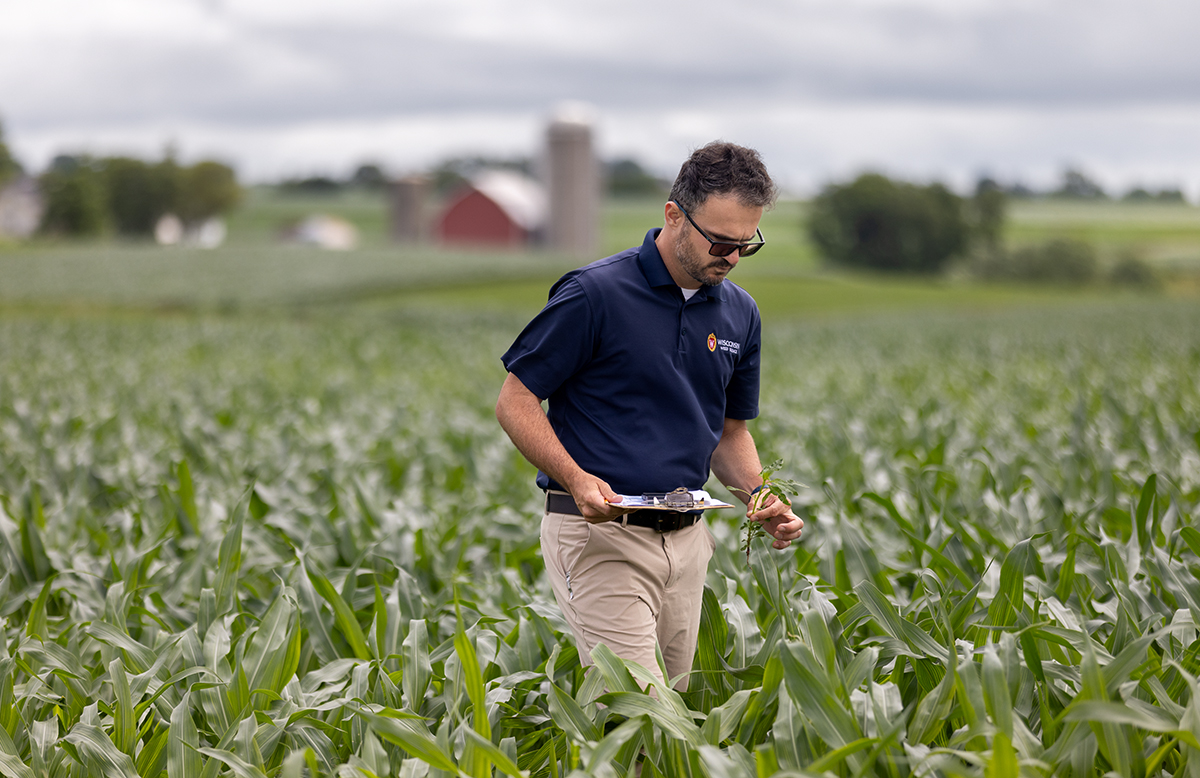
Rodrigo Werle wonders if anybody is ever really happy to see him.
He is, after all, a weed scientist. He specializes in some of the nastiest, most unwelcome guests to visit Wisconsin farm fields. The kind that just won’t leave.
“Nobody wants to be in the same field where we do research,” says Werle, an associate professor of plant and agroecosystem sciences and extension scientist. “We want to work where there’s giant ragweed and waterhemp and all the hardest-to-control weeds we have out there.”
So, when he first laid eyes on Arlington Agricultural Research Station during his 2017 job interview, he began imagining all kinds of research possibilities. Arlington is one of 12 UW agricultural research stations dotting Wisconsin. One of the primary goals of these stations, which are maintained and operated by CALS, is to develop useful recommendations for farmers and landowners.
“During the tour, I thought, ‘Wow, imagine what I could do at a place like this,’ ” Werle says.
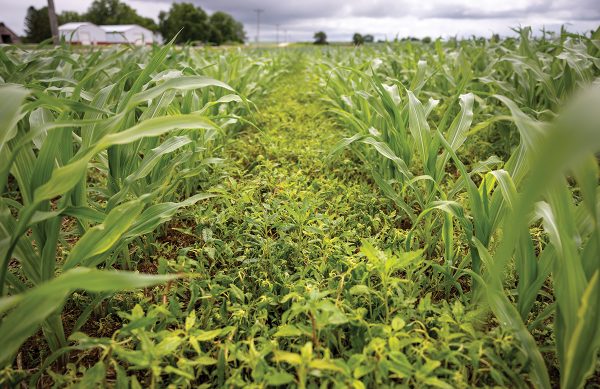
What he could do was dig in alongside the herbicide-resistant weeds and figure out how to get under their skin. He could try out ways farmers can control weeds with less herbicide — while protecting or even improving precious soil — in an environment that represents the best possible combination of working farm and working laboratory.
“There’s a tremendous need for long-term studies that lead to meaningful conclusions supporting useful recommendations for farmers,” Werle says.
But testing new ideas is labor-intensive for farmers who are trying to keep their operations profitable. It requires an unwavering commitment of acreage and time. And it demands a willingness to accept the prospect of failure. That’s a lot to pile on top of the market swings, weather extremes, and razor-thin margins farmers already face.
“Our farmers are great partners, but maintaining complex, long-term studies, year after year on their farms would be very difficult,” Werle says. “We can do those studies at our research stations, which reflect the soil and practices of the stakeholders in the region, and in fields they can walk into to see the results for themselves.”
That was the goal from the start when what would become UW’s College of Agricultural and Life Sciences began establishing research outposts more than a century ago in places like Marshfield, Sturgeon Bay, and Spooner.
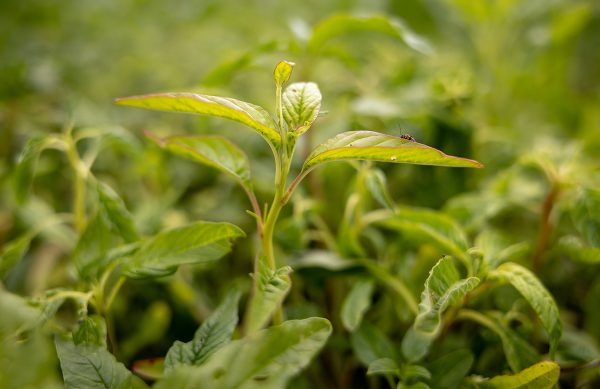
“Wisconsin is very diverse when you think of all the soil types and agricultural commodities grown in different parts of the state,” says Mike Peters BS’95, director of the Agricultural Research Stations. “We do great work at Arlington, but it sits on 24 inches of beautiful topsoil. What works in that environment is not going to convince someone farming the sandy loam soil near Spooner.”
One thing the stations have in common is the way they’ve drawn talented scientists from around the country and the world to work shoulder-to-shoulder with Wisconsin farmers to solve specific problems and keep them competitive in global markets.
Lancaster
Not long after Werle started at UW, the unique conditions in southwestern Wisconsin drew him to the Lancaster Agricultural Research Station. It was founded in the 1960s with a focus on developing conservation farming and grazing methods that would revitalize farms where prevailing methods had worn out land and washed valuable topsoil off the rolling slopes of the Driftless region.
“Lancaster station has a special place in my heart,” Werle says. “When I started working at UW, waterhemp, the worst weed for corn and soybean production in the state, was present, which enabled us to establish high-impact research immediately after my arrival in Wisconsin.”
Waterhemp is a stubborn type of pigweed that crowds out corn and soybeans and robs them of nutrients, water, and space. It has a particular knack for outfoxing the chemicals designed to kill it, developing resistance to herbicides almost as fast as they can be approved for use.
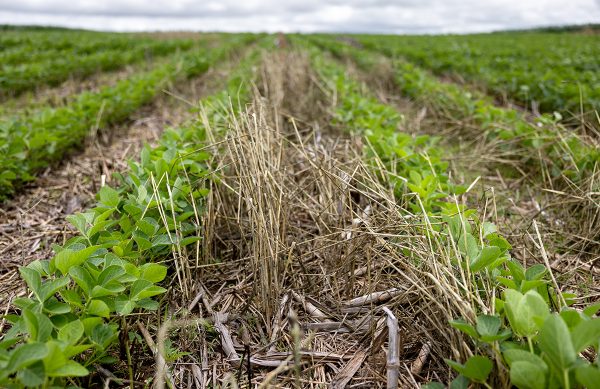
Every year, farmers bring him garbage bags full of weeds from their fields for his lab to test for resistance. Six years ago, about 10% of the waterhemp plants screened survived labeled rates of auxin herbicides, common synthetic weed killers. By 2023, it was already up to 50%.
“Relying on chemistry alone is not sustainable because of that resistance evolution speed observed in waterhemp,” Werle says.
Since 2018, Werle and Daniel Smith MS’16, crops and soils program manager for the UW Division of Extension, have kept up an experiment comparing different weed management practices side-by-side, from the most conventionally tilled soil sprayed repeatedly with herbicides to no-till plots that cut back on spraying in favor of cover crops — in this case, winter (cereal) rye.
“We agreed that we need to do something different, something that stakeholders can buy into,” Smith says. “So, we started designing a trial we thought would be applicable to the Driftless region. And we do this same thing at Arlington, with a range of no-tillage approaches to manage soil retention, moisture, and weeds.”
The differences are stark, even on a windy day in late June, when the corn stalks still seem so small. The tilled rows, where the soil has been turned over year after year, sit noticeably lower, some of the soil washed away forever without roots to retain it. And there’s waterhemp. Even after fresh applications of herbicide, many of the weeds are hanging on, only slightly damaged.
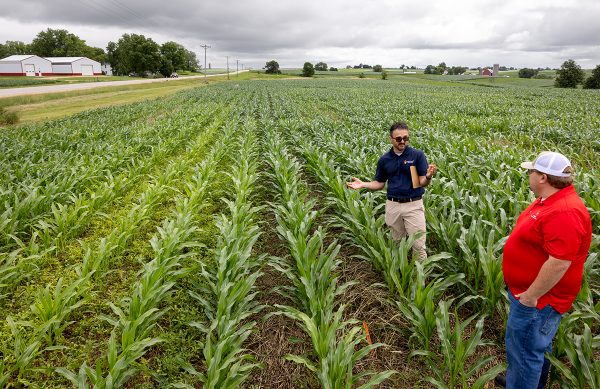
But where they’ve grown winter rye as a cover crop, barely any weeds are visible. In fact, you can hardly see anything for the dense carpet of rye stalks covering the ground. Werle and Smith have let the winter rye grow right up to the moment farmers “plant green” — planting rows of corn directly into the still-thriving cover crop. Then they kill off the rye with a single application of an herbicide, which doesn’t bother the corn. Organic farmers could use a roller crimper machine to kill the rye without an herbicide.
“This cover crop, if you let it grow long enough and develop enough biomass, becomes a mulch on top of the soil surface,” Werle says. “That mulch alters the environmental conditions in the top layer of soil. Most weeds, like our waterhemp, need fluctuations in the temperature of the soil to trigger seed germination. The mulch buffers those temperature fluctuations and tricks the weed seeds into not germinating. It’s fascinating.”
And it’s effective. By reducing their exclusive reliance on herbicide for waterhemp management, farmers give the weed fewer chances to develop resistance to the chemicals.
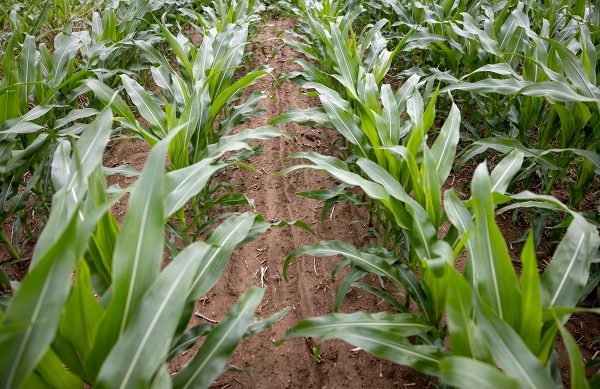
Hundreds of farmers have seen the results during research station field days, where Werle, Smith, and other researchers can quite literally walk them through the experiments. It’s a chance for crowds of growers to step through rows of cover crop examples, herbicide trials, new technology demonstrations and, for experienced farmers like Jake Kaderly, to pepper Werle with questions.
“In the old days, herbicides worked on everything,” says Kaderly, who farms near Juda and works as an agronomist advising other farmers. “But nature adapts and overcomes, so we need to find ways to stay ahead.”
His clients, though, are often reluctant to shift away from practices they’ve grown comfortable with, even as those practices become less successful.
“It’s not easy to talk about these things if it’s not the way their farm’s been working for years,” Kaderly says. “You’re not going to consider a change if it feels like a risk. Well, in Rodrigo’s research fields, you can see it working. You see the proof.”
Arlington
Werle’s work shows farmers that a change in methods can improve their productivity and their bottom line. Meanwhile, at Arlington Agricultural Research Station (only about 20 miles north of the UW campus), Lautaro Rostoll-Cangiano is studying how differences in diet and environment affect the development of bovine immune systems. An assistant professor of animal and dairy sciences, he is conducting this research to help Wisconsin farmers as they race into lucrative new ways of managing their beef and dairy cattle while also improving herd health and disease resilience.
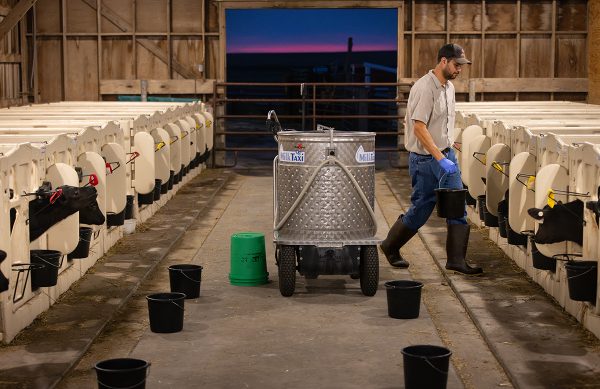
To keep producing milk, dairy cows need to give birth to new calves every year. For decades, farmers focused on using calves to replace milking cows and improve their productivity over time. But Heather White, an animal and dairy sciences professor who studies cow nutrition, says breeding has become so successful that farmers no longer need so many replacement calves to achieve those goals. “But we still need to have calves for milk production, so the farmers went looking for other opportunities,” she adds.
Between record high beef prices and some of the lowest numbers of dairy herds and cows in decades, dairy farmers have found the new and profitable solution of breeding some of their less-productive milking animals — as much as half their herd in some cases — with meat-producing breeds like Angus cattle. Those crossbred calves, called “beef x dairy” or “beef-on-dairy” crosses, are sold or raised as beef cattle.
“They’re getting premium prices that they’d never get for dairy calves,” says Arin Crooks BS’97, MS’00, who is superintendent of the Lancaster station and has expertise in animal genetics and meat science. “Dairy farmers have really run with this, and you can’t blame them.”
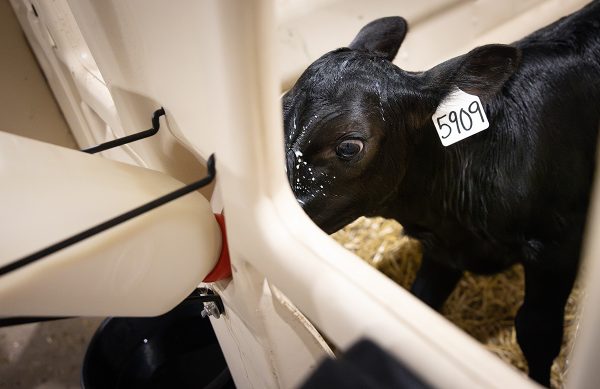
But they’re also running into relatively unknown territory. “More and more farmers are breeding their dairy cows with beef cattle,” says Rostoll-Cangiano. “But we don’t know much about the best ways to raise those calves.”
Decades of nutritional research have led to optimized diets that look very different depending on a cow’s future “career” as a meat or milk producer. All calves, White explains, need to start on colostrum — the milk produced by their dam (mother) shortly after calving. But after that, the plane of nutrition needs may differ. Dairy calves are fed to mature quickly so they can have a calf of their own within two years and start being milked.
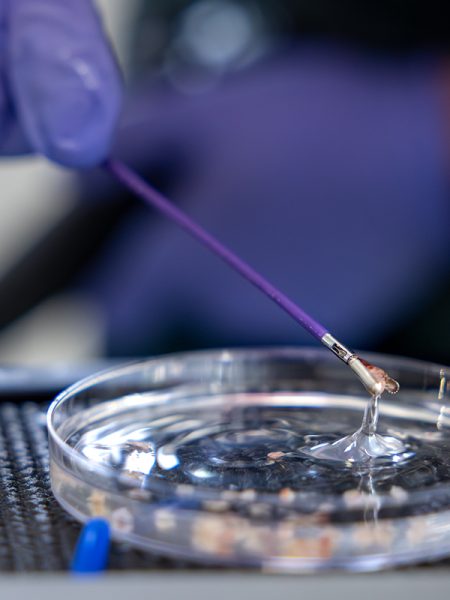
“Beef calves, however, are generally raised suckling their dam on pasture,” White says. “That represents a different nutritional plane, with the primary goal of achieving desired muscle qualities.”
But, what to do with beef-on-dairy crosses? Should they eat what a dairy calf eats or what a beef calf eats? Or should they have a hybrid diet?
“The farmers have a lot of questions on how to raise these animals, how to feed these animals,” says Rostoll-Cangiano. “We want to know how to use that diet to best program their immune system to keep them healthy.”
His lab is studying a group of new beef-on-dairy calves, trying out a diet with probiotics to see how they affect microbial communities in the calves’ guts and shape their immune systems.
Little black calves growing up at the Arlington station are fed experimental diets and tracked as they grow. When they are one month old and then again at two months, Rostoll-Cangiano and graduate student Martina Mancheno take tissue samples in a procedure that looks a lot like a human colonoscopy. While the calm, curious animals sniff medical equipment, Mancheno operates an instrument that collects tiny bits of the inner walls of the animal’s lower intestines. From those samples, they can isolate the different immune cell types developing in the calves’ digestive tracts and assess their defenses against infections and other disorders.
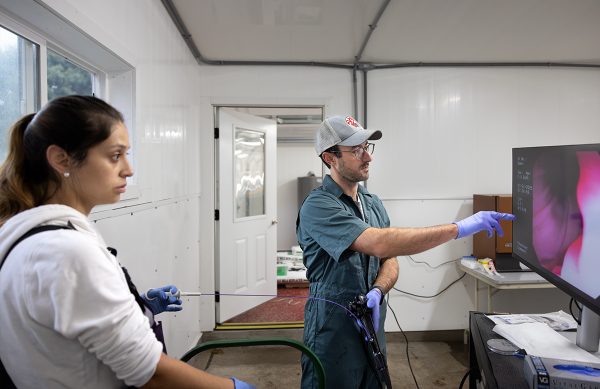
“It’s interesting to work in the lab, where the results tell us what’s going on,” Mancheno says. “But I like to come out here and work on the farm more, to be with the animals.”
That, Rostoll-Cangiano says, is what makes Arlington — with its large herd of cows and centers for sheep and pigs and plant and soil science, to boot — an invaluable resource.
“We have tremendous facilities,” he says. “We are one of the only universities in the country that has this kind of access to animals and also the staff that understand both a research facility and a farm environment in a way that makes our research as useful as it can be.”
Hancock
Located in Wisconsin’s aptly named Central Sands region, Hancock Agricultural Research Station might just usher in a new era for corn growers in Wisconsin and around the world.
As one might guess, ample watering is necessary in these sandy fields that drain like a bathtub with the plug pulled, washing away most of the nutrients in the process — including all of the nitrogen. As it happens, that’s exactly what Jean-Michel Ané was looking for.

“We’re so lucky to have Hancock station,” says Ané, a professor of plant and agroecosystem sciences and bacteriology whose work is supported by the U.S. Department of Agriculture, the U.S. Department of Energy, and the National Science Foundation. “It’s actually very unique in the United States and perfect for field trials of our corn hybrids.”
To fully grasp the significance of these hybrids, it’s important to know that corn needs nitrogen to grow — a lot of it. Farmers in the United States spent around $11 billion on synthetic nitrogen fertilizer for roughly 95 million acres of corn in 2025. But that’s not the only way to measure the cost, says Ané. For example, some of the fertilizer tends to leach out of fields after it’s applied. Nitrates, compounds formed when the nitrogen-laden ammonia in fertilizer reacts with oxygen, are the most widespread pollutants in Wisconsin’s groundwater.
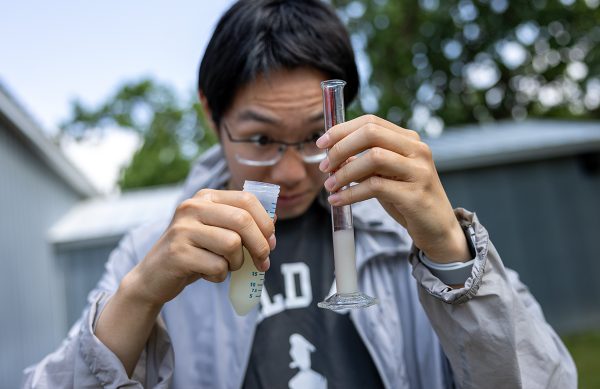
For more than a decade, Ané has been studying varieties of corn from Oaxaca, Mexico, that have found their own source of nitrogen: They pull it right out of the air. (See Of Mutant Wranglers and Slime Whisperers, Grow, fall 2020.)
It’s a trick that beans and peas and other legumes have already mastered — with help from symbiotic bacteria. These microbes convert, or “fix,” the airborne nitrogen, which floats around as paired atoms of nitrogen, into molecules of ammonia (three hydrogen atoms bound to one nitrogen atom). The microbes’ partner plants can use the nitrogen in ammonia to build necessary proteins and DNA.
“These cultivars of maize from Mexico also have this relationship with nitrogen-fixing bacteria that is very happy living in a gel produced by bundles of roots that grow out from the stalks into the air,” Ané says. “They can get as much as 80% of their nitrogen from the air through bacterial colonies that live on their roots.”
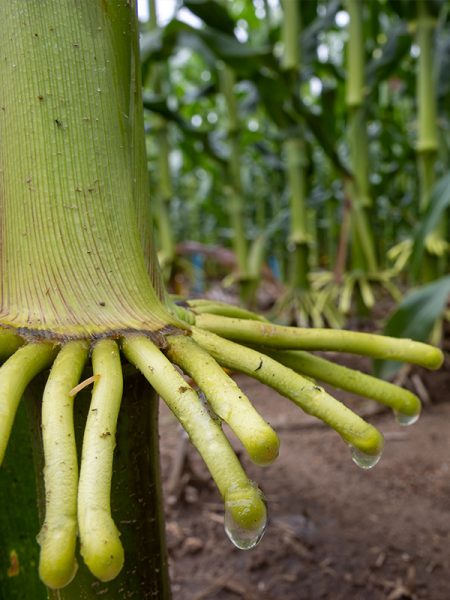
That’s very unusual for corn. Corn varieties typically grown in the Midwestern United States are getting 99% of their nitrogen from their farmers. They’re built just right for the Midwest in other ways, too. They’ve been bred and selected to sprout, flower, and produce ears of corn at just the right times for Wisconsin’s growing season and in just the right stature (10 to 12 feet) to line up neatly in rows and bask in the sun.
The Oaxacan corn is quite different. It grows to 16 feet or more, towering over typical Midwestern farm varieties. It’s comfortable in three- or fourplant clumps, not straight rows, and it likes to grow side stalks that don’t produce ears of kernels. It also prefers to flower on a tropical calendar.
In short, the Oaxacan corn is prone to falling over in Wisconsin weather and wasting its energy as well as a farmer’s time and money. Ané’s lab wants to breed those unappealing characteristics out of the corn while keeping its amazing nitrogen-fixing ability intact.
“We’re crossing the Oaxacan plants with Midwest corn varieties to get plants that do what Wisconsin farmers want them to do without needing nitrogen fertilizer,” says Rubens Diogo Jr., a postdoctoral researcher in Ané’s lab.
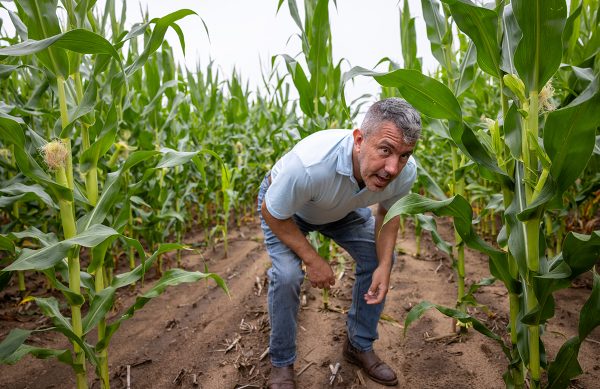
Diogo has spent many of his summer days at the Hancock station running field trials of the nitrogen-fixing corn hybrids. In 2024, they grew 12 hybrids. That season went so well, Diogo reports with a giddy smile, that the lab crossed promising varieties from 2024 with even more Midwestern varieties to create 152 new hybrids to grow in 2025. The scale of the study is staggering: 1,400 plots with more than 200,000 corn plants and (maybe) a new future emerging from Hancock fields.
“In 2024, some of our crosses got no added nitrogen at all but produced the same yield as the plants that got all the fertilizer they would on a typical farm,” Diogo says. “That’s big.”
Hancock’s sandy soil drains so thoroughly it is almost completely empty of nitrogen when the calendar turns to spring. “That gives us a very useful baseline to work from in our experiments,” Diogo says. “We know if we don’t put nitrogen into a field like a typical farm would, the plants in that field aren’t getting nitrogen left over from past years.”
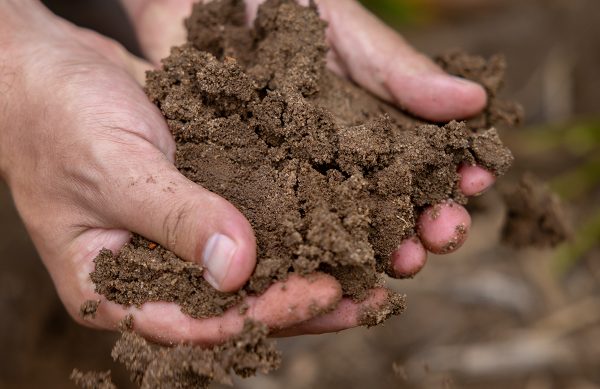
Back in the early summer of 2025, Diogo’s crew of undergraduate students had walked the rows of hybrid corn, spraying the plants with a slurry that includes three strains of nitrogen-fixing bacteria grown in Ané’s lab. About half the plants of each hybrid corn variety were fertilized like a typical Wisconsin corn field in their own plot. The other half, grown in a separate plot, went without.
Then, in late July, crunching through a sandy Hancock field between tall stalks of corn, Diogo points out rows of experimental hybrids that look promising — with clumps of chubby roots reaching out into the air about 10 inches off the ground — and rows that look like duds, sporting few or no air roots and withering leaves.
These plants will be harvested in the fall and analyzed for key production measures, such as height, flowering times, and grain quantity. That data will help them answer the most common question they get from the Wisconsin farmers who have both seen the plants and heard Diogo and Ané describe their promising results.
“They want to know about applying the bacteria and yield and things like that,” Diogo says. “But they get excited and, really, they have one question for us: When will I be able to plant these plants?”
For the Future of Farming
The future is where the farmers are looking when they turn to the UW scientists and staff working at the research stations. It could be a generation in the future. Or next year. Or later that afternoon, as they speed-dial Rodrigo Werle’s phone while standing over a stubborn patch of weeds.
“It’s a great team, with Extension,” Charles Hammer says of the UW researchers. “They have ideas. We have ideas. We’re coming together to compare notes as we go. To have a group like this, people that are always looking to the future, is very valuable.”
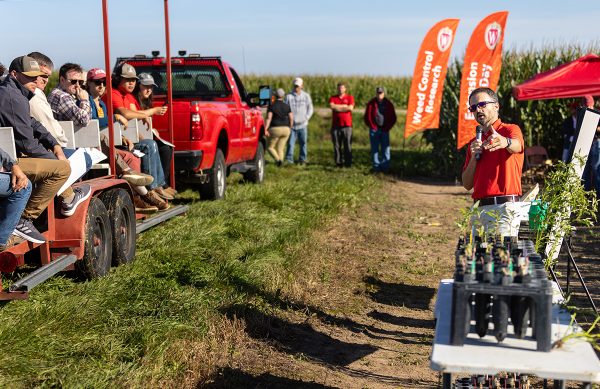
Hammer, with a partner, farms about 1,800 acres in Dodge County, growing corn, soybeans and wheat, among other things. To maximize his farm’s success, he makes sure he takes every
opportunity to pick scientists’ brains and walk the station fields where they’ve done their work.
That makes looking after the future of the Agricultural Research Stations important, too.
Mike Peters can rattle off a seemingly endless list of projects around the network of research stations. Scientists are tracking diseases such as potato blight, publishing annual reports on new varieties of crops, working on drought-hardy turfgrass, and more. While the researchers working at the stations are constantly pushing boundaries and producing new knowledge, the facilities themselves only age.
“UW faculty are charged with solving the next generation’s problems,” Peters says. “All the producers in the state of Wisconsin, regardless of agricultural commodity, rely on UW–Madison for information to help them succeed. We want to be forward-thinking for those people. With support, we can make investments in technologies and equipment and facilities that address emerging problems and emerging crops and supply new ideas for Wisconsin to grow.”
Funding Research for Farmers
UW’s Agricultural Research Station network is supported by the university and state and federal funding. Individual on-station research projects are funded by a variety of sources, including the U.S. Department of Agriculture, National Science Foundation, U.S. Department of Energy, National Aeronautics and Space Administration, Wisconsin Department of Natural Resources, agricultural commodity groups, private industry, and other sources.
This article was posted in Changing Climate, Cover Story, Economic and Community Development, Fall 2025, Features, Food Systems and tagged Agricultural Research Stations, Arlington Agricultural Research Station, beef-on-dairy, Corn, cover crops, Division of Extension, Hancock Agricultural Research Station, Jean-Michel Ané, Lautaro Rostoll-Cangiano, Mike Peters, nitrogen fixation, Rodrigo Werle, UW–Madison’s Lancaster Agricultural Research Station, waterhemp.

